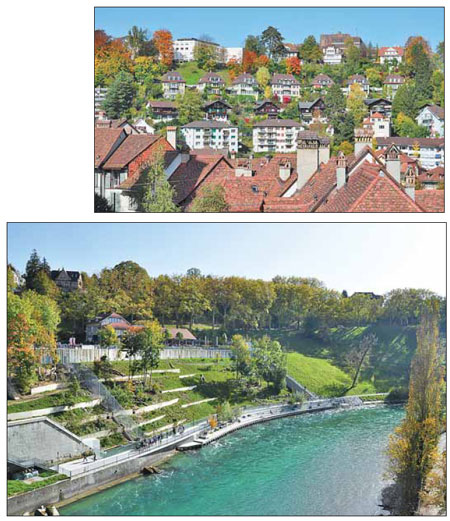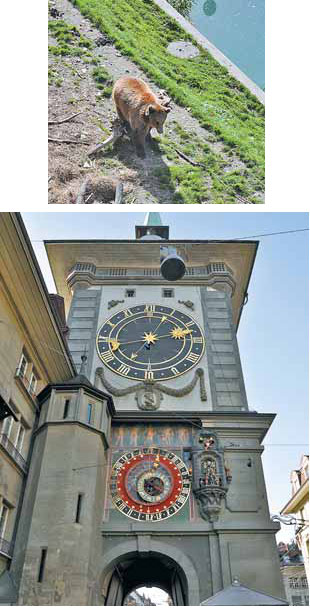Bear moment in Bern
Updated: 2013-03-31 08:23
By Jofelle Tesorio(China Daily)
|
|||||||
|
Top: The best panoramic view anyone can have from the Munsterplattform. Above: Aare River envelops the city of Bern and remains one of the biggest attractions that is always beautiful at any given season. Photos by Jofelle Tesorio / for China Daily |
|
Top: These well-loved bears find their new habitat more natural than the old bear pit. Above: Zytglogge clock tower at the end of Bern's shopping promenade was Albert Einstein's inspiration for his law of gravity. There's a carousel that pops out from the clock every hour. |
If Chengdu has pandas, Bern has bears. Jofelle Tesorio finds out how the Swiss capital and its citizens struggle to keep the bears in the pit while treating them more as important symbols and not just tourist attractions.
'If you think Geneva is the capital of Switzerland, you're grossly wrong!" Hans, an old family friend exclaims, as he brings us around the cobbled city center of Bern. Born, raised and spent all his life in Bern, he exudes an air of pride talking about the city's history. He was speaking in perfect English, the favorite second language edging French.
Since we arrived two days before, I have been hearing 'merci' all the time and got confused whether German or French is the spoken language.
Most of the Bernese speak Swiss-German but since the nearest French-speaking canton is just 12 km away, they're used to saying 'merci', instead of 'danke'!
But I would imagine German is the most logical language for the Bernese since we only traveled for two hours from Freiburg, West Germany to reach the city.
I was guilty as charged for not doing my homework.
But like most travelers from outside Europe, Bern is perhaps more known for its bears and Albert Einstein, but not for the seat of government.
Founded in 1191 by Duke Berthold V. von Zahringen, Bern became the capital of Switzerland in 1848. Given its rich historical past, Bern has retained a medieval atmosphere, which is very special for a capital city.
Most capitals these days are so in a rush to catch up on development, building this and that. Not Bern. This city seems suspended in time and the Bernese are known as laid-back people.
Buildings and monuments from the 14th to 16th century are well preserved. The city square has mostly original cobbled walks from centuries ago, painted fountains, towers and medieval craft guilds. Many of the original structures built on local sandstones are still intact.
With this superb preservation work, Bern has another claim to fame - a UNESCO Heritage Site. Not many capital cities in the world have a stamp of a heritage site. Perhaps its smallness and old charm make the difference. I would never have guessed that it is the Swiss capital.
Walking around the city and stopping at the Mnsterplattform, a terrace-like park with chestnut and lime trees all and with a panoramic view of Bern - the castle from afar, the Aare River below, the cathedral, and the bridge that serves as the entrance to the city center - I can not help but gasp at the beauty of this city and almost forget to ask our host about the bears.
After what seems an eternity of talking about Swiss life, Hans decides we should see the bear park along the river.
A throng of tourists is looking down from the 100-year-old Nydegg Bridge. "There's the bear!" shouts one tourist. One slightly plump bear appears from its hiding place.
A few minutes later, another one comes tagging along, then the third, which looks smaller than the earlier two. They run around playfully, not minding the snaps of cameras and shouting from delighted viewers above.
Opened in late 2009, the new bear park covers 6,000 square meters and has caves and a pool. It is supposed to create a more natural habitat for the animals.
This is a big improvement from the old bear pit just a few meters away, which many people criticize as inhumane or worse, a disgrace to animal-loving Switzerland. The investment is worth it since the bears are attracting more than a million tourists a year.
Just how important are bears in the city's heritage? It is believed that its name was derived from the German word 'bar' or bear.
Since 16th century, caged bears have been kept in the city. There was also a part in history when the Bernese Army, fresh from military victory, arrived with a living bear as loot. From then on, bears were immortalized and featured in the city's flag and coat-of-arms.
There are plenty of things around the bear park. Children and children-at-heart can have their photos at a bear statue, visit the small bear museum or simply hang out in cafes and marvel at the meandering river and the surrounding hills, and the parallel rows of houses with brick-colored thatched roofs.
After spending some time around the bear park, we headed back to the city center to examine other attractions.
The Bern Munster stood mightily from a distance like a rocket ready to launch. We covet its beauty from the outside because of time constraint.
Besides having the tallest spire and bell tower in the country, it is also home to some important medieval arts such as the Last Judgment that contains more than 200 carved wood and stone figures.
Along the street, I notice several small closed doors that lead underground. Our host explains that normally these are bars and cafes that open late in the afternoon or evening.
During the day, they look like boring doors to equally dreary garages but I can imagine how they transform in the evening.
The line of "garage doors" stops just below the medieval clock tower or the Zytglogge, Bern's first western city gate.
It is said to be Albert Einstein's inspiration for the law of gravity in 1905 while working in the patent office. (He conceived it while looking at the clock from the back of the train.) For more of this great Bern inhabitant (who lived in 49 Kramgasse with his wife and son), there's an Einstein Museum at Helvetiaplatz, just across the river.
Our last stop was the Federal Building that houses the Parliament. Built in 1902 with Florentine Renaissance style, the building is surrounded by other important edifices such as the justice hall and the central bank.
In front, a fountain danced gracefully covering almost its entire facade. My research tells me that the fountain releases 26 squirts, one for each Swiss state. With bare eyes, it is difficult to tell how many squirts are there actually but I have no doubts about the Swiss' precision.
Contact the writer at sundayed@chinadaily.com.cn.

(China Daily 03/31/2013 page16)

